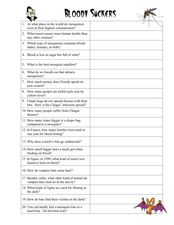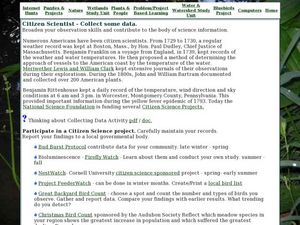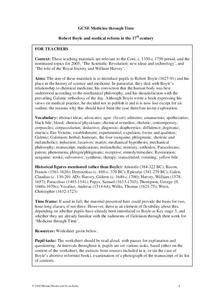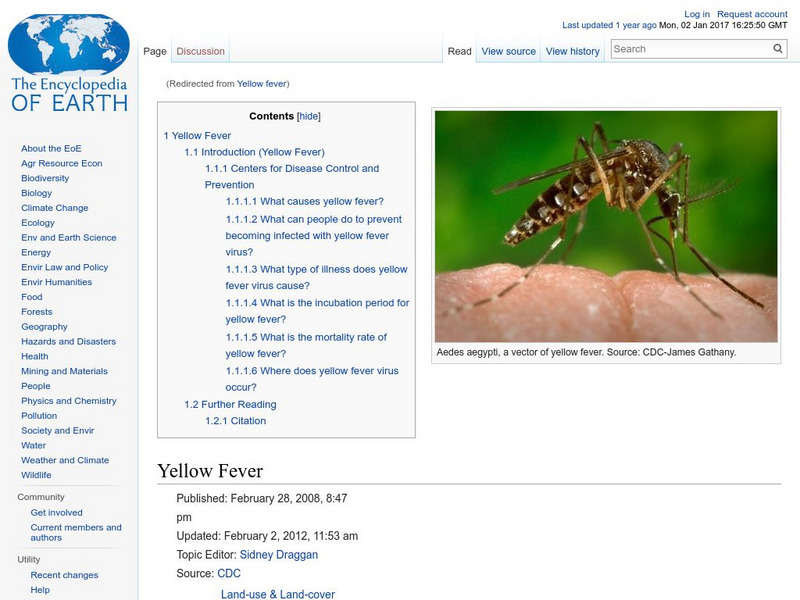Curated OER
Walter Reed's Yellow Fever Studies
Middle schoolers and high schoolers examine the ethics of using human test subjects in scientific research. They do a simulation which focuses on yellow fever and how human subjects were used to develop a treatment/cure for the disease...
Curated OER
Science: Finlay and Yellow Fever
Ninth graders research the work of Carlos J. Finlay and his contributions to science. Once they have discussed his theories about diseases, they create tables comparing diseases that use insects as carriers. The lesson also includes a...
Curated OER
Climate Change And Disease
Students consider the role of climate change in the occurrence of vector born diseases such as malaria. In small groups, they research a specific vector to complete an information chart on climate changes in the region where the vector...
Curated OER
Designing Experiments - Procedures for Teachers
Students evaluate a hypothetical experimental design and attempt to improve upon it. In this scientific method lesson, students are presented with an experiment and are instructed to determine its flaws. They conduct their own experiment...
Curated OER
Diseases You Can Catch
In this communicable diseases worksheet, students research 26 diseases and determine which are caused by viruses and which are caused by bacteria. After researching, they complete 11 short answer questions about signs and symptoms of...
Curated OER
Mosquito Life Cycle
Seventh graders investigate the life cycle of the mosquito. In this life cycle lesson, 7th graders gain knowledge about the diseases mosquitos carry. Students breed mosquitos and investigate their eggs. Students collect and record data...
Curated OER
Bloody Suckers
In this blood sucking animals activity, students answer 20 questions about leeches, mosquitoes, Chepo bugs, and bats which all suck blood to transmit diseases or get nutrients.
PBS
Stories of Painkiller Addiction: Learning About Opioids
Feeling high is not the only side effect of abusing prescription opioids. Middle and high schoolers learn more about specific painkillers, including Fentanyl, Oxycodone, and Clonazepam, as well as their common brand names and extensive...
Curated OER
The Final Word
Middle schoolers research biographies of Americans who advanced science. They create an obituary for the person to share what information they have gathered. They discuss the importance of the obituary as the "final word" of a person to...
Curated OER
Researching Infectious Diseases
In this researching infectious diseases instructional activity, students write a report on one of the infectious diseases listed, using the web links for research, then answering 13 short answer questions about it.
Curated OER
Citizen Scientist - Collect Some Data
In this science project worksheet, students view a sheet of numerous science projects including weather, animals, flowers, and more. Students choose 1 project to do out of 22 projects total.
Michael Hunter and Fiona Kisby
Robert Boyle and Medical Reform in the 17th Century
Introduce pupils to the work of Robert Boyle and his influence on medical practice through a series of informational texts and discussion questions.
Curated OER
The Trial of the Bloody Sucker
Students study creatures that drink blood. In this blood suckers lessons, students watch videos to learn about creatures that drink blood. Students divide into groups and make posters about the organisms. Students then participate in a...
PBS
Pbs Learning Media: Primary Source Set: The Yellow Fever Epidemic of 1878
This collection uses primary sources to explore the Yellow Fever Epidemic of 1878.
Centers for Disease Control and Prevention
Centers for Disease Control: Yellow Fever
This site from the Centers for Disease Control and Prevention has information on yellow fever. The site is broken into the following sections: Yellow Fever Disease, Yellow Fever Vaccine Requirements, Yellow Fever Precautions, and Risk...
Encyclopedia of Earth
Encyclopedia of Earth: Entomology: Yellow Fever
Information about yellow fever, a disease transmitted by mosquitoes in tropical areas. The article discusses how to prevent yellow fever, and how the disease affects a person. (Published: February 28, 2008)
World Health Organization
World Health Organization: Yellow Fever
Site about Yellow Fever, vaccine, countries at risk in Africa, control, and epidemiology of yellow fever in 1994 and 1995. This site also has a great table of the number of cases and deaths reported to the World Health Organization...
Harvard University
Harvard University Library Open Collections Program: The Yellow Fever
Students investigate the yellow fever epidemic in Philadelphia. Some topics explored are Benjamin Rush, the Santo Domingan influence, and background information on the yellow fever. Additional resources include web pages, references, and...
Library of Congress
Loc: America's Story: Yellow Fever Cause Discovered
You have probably never heard of anyone you know having Yellow Fever. But in the early 1900s, it was mysterious as well as deadly. How was it transmitted? What did people do to try to prevent getting sick? Read the story at this site.
The College of Physicians
The History of Vaccines
Complete medical education project explores the role and uses of vaccines now and in the past. Find information and analysis about vaccination controversies; answers to frequent questions about vaccinations; timelines of diseases,...
University of Virginia
Univ. Of Virginia: Walter Reed and James Carroll
Walter Reed served in the US Army Medical Corps in the late 1800s. James Carroll pursued his medical degree after enlisting in the US Army. This site details the efforts of these men and others who worked to pin down the way Yellow Fever...
Patsy Stevens
Garden of Praise: Walter Reed: Physician
The Garden of Praise profiles the life of Dr. Walter Reed (1851-1902), whose pioneering work in yellow fever research made the connection between insects and the transmission of disease. Text is geared toward younger students.
Arlington Cemetery
Arlington National Cemetery: Walter Reed
This site from the Arlington National Cemetery provides an easy to read account of the life and work of Dr. Walter Reed (1851-1902 CE), Major in the United States Army Medical Corps who proved that yellow fever was transmitted by...
Houghton Mifflin Harcourt
Harcourt: Biographies: Gail Borden, Jr. 1801 1874
Good resource for biographical information on Gail Borden who was a teacher, soldier, surveyor, tax collector, missionary, but most of all an inventor. Best known for his invention of condensed milk.
Other popular searches
- Yellow Fever Epidemic
- Yellow Fever 1793
- Yellow Fever Civil War
- Yellow Fever Calculations
- Yellow Fever Philadelphia
- Yellow Fever Wilmington






















